POST OFFICE SERVICES
A Brief History of Postal and
Telephone Services at Blisworth
Extended from a series of articles by G
Freeston in "Round & About"
During the previous 200
years, Blisworth played an important part in postal history. Towards the end of
the 19th century postal communication extended throughout the county. The
ancient routes such as Watling Street running through Towcester came fully into
use. In 1794 horse-drawn Royal Mail coaches were brought into operation. The
London to Chester coach passed through Towcester, which became a post staging
place. Here the mails for Northampton and up to Thrapston were transferred by
post boys on horseback and later by postal carts passing through Blioworth.
Retracing our story back to 1793 when work on digging the Grand Junction Canal
began at Blisworth, as if anticipating the need for an improved road from
Toweester to Northampton for the movement of merchandise arriving at the canal
wharfs, in 1796 the length of road became a Turnpike Road complete with toll
gates and milestones, two of which are within our parish and are the only
survivors between Towcester and Northampton. The new Turnpike was called the
"Oxford to Cotton End' road and, incidently was moved west of the Easton
Neston "estate" by influence of a proud family who preferred
isolation. A new 'Grafton
Arms' coaching inn was built
near West Bridge (now Grafton House). During the following years the running of
the Royal Mail coaches reached the peak of their efficiency, A rapid decline
followed as railways were introduced, for the speed of the steam train was
double that of the horse-drawn coaches. Thus with the coming of the London to
Birmingham line through Blisworth in 1838, not only were local mails carried by
train but the mails for Northampton and district were also handled at Blisworth.
At first, owing to the slowness of the early trains, the mails were virtually
man-handled to and from the train while in motion, but as speeds improved mail
bags were ejected from the mail coach into a large capturing net cage and the
outgoing mail bags were hung from a kind of gibbet and collected as the train
rushed by. Occasionally accidents occurred with the transfer of the bags. Local
lore mentions they
were torn open and the contents strewn over the lines and embankment but the
account by Mr Ayres plays all that
down. Mails were
carried to and from Towcester and Northampton by mail messengers. There
was bag catching apparatus on both sides of the track thought to be some short distance south
of the bridge over the canal. Mr. Clark of Bugbrooke has told us that road
access was near to the apparatus and therefore it is much more likely that the
apparatus was near the Arch. Expresses fell into two categories
apparently, one
which treated Blisworth as the first stop out of London for which the 4 minute
wait was plenty long enough to deposit mailbags on the platform, and the through
expresses, more usually at night, which employed the catching apparatus.
The problem with these snippets of information is that they may not have been
correct for very long. An aerial photo from 1947 (NRO) shows nothing
that helps solve this question. A c1910 scale 240:1 map of the entire
station area, owned by A. Newbery but originally collected by GF, shows no pole
or apparatus anywhere near the station. It does however clearly show what
has been taken in the past as a platelayers' hut halfway up the embankment on
the towpath side of the railway canal bridge. It would be feasible to use
that hut as a base and wheel the bags to the bridge (Stockwell Br.) to meet up
with "the cart", as Mr. Ayres describes it, on Ford Lane. A
Mr. Roger Robson who worked at the station for many years thought that the
"down" express from London ejected the mail into a net on the
Blisworth side of the embankment, about halfway between the canal and the road
bridges. He thought the "up" train called briefly at the station
and not use the apparatus. The topic was placed on the SMJ on-line forum, www.smj.me
, for analysis on Dec3rd, 2010 and Mr Robson's view on location was proved
correct. A David Chambers, owner of a linen-based old map shows the
apparatus for both up and down lines, along with postman huts, between the
bridges. The route for the postmen to a road was
probably down the embankment to the west and straight across the field to
Stockwell Bridge (from which some remains of a pathway can still be made out).
Derek Smeathers (Northampton - local expert on all
postal matters) is pleased to learn of the "catchers' location" having
tried, along with George Freeston, to gain this
information for many years. The name is new to him; the
usual description in postal circles is a "mail exchange apparatus".
In a little handbook published in
1971 by Harold S Wilson are some details about the apparatus. The original
design for the apparatus was made by Nathaniel Worsdell in late 1837, but the
GPO refused to buy his patent and behind his back they encouraged a young Post
Office worker to produce a fresh design. It was his apparatus that was erected
at Blisworth but it apparently failed or gave so much trouble that it was
abandoned after a few weeks. It must have been replaced or repaired as referred
to in the GPO accounts of 9th June 1840.
Derek Smeathers has a copy of a
Time Bill of 1860 for the Irish Mail train which left Euston at 8.30pm and used
the Blisworth apparatus at 9.59pm and the Weedon apparatus 9 minutes later!
By 1890, quite a number of the Mail Trains were calling at Northampton and thus
avoiding Blisworth, though the Liverpool Morning and Day Mails both called at
Blisworth (first stop from Euston) using apparatus at Bletchley and Watford
Junction but not at Blisworth since there would be time to offload onto the
platform. Thus the utilisation of the catchers changed over the years as
routes, timings and technology changed and accounts for the minor contradictions
in the previous paragraph.
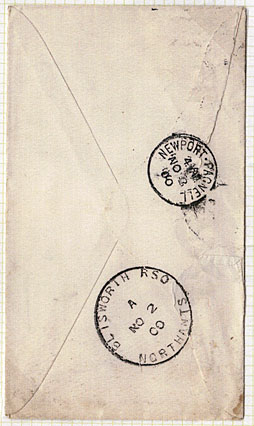 In 1845 the branch line from Blisworth to Peterborough
was opened. This then put Northampton on a direct communication with the main
line here. Mail continued to come to Blisworth with the same use of the catch
nets but now the mails for Northampton were carried by hand along the line to
the station and forwarded by train. Mails for the Towcester area continued to be
taken by Mail cart until the railway to Towcester was opened in 1866. Even after
the area had total rail communication, high speed trains continued to use the
'eject and pick up' method until World War II. This had to be discontinued owing
to the enforced black-outs for as the apparatus was along the high embankment
between the station and the arch, torches and lanterns had to be used. From
about 1860, Blisworth station became designated as a Railway Sub Office (RSO) at which
some sorting was done and this was all that was necessary for letters addressed
to the village, apart from the person's name. There is a
1936 directory copied to this site which might have been used at the RSO to
work out who lived where. The inset shows an example of an RSO
stamped envelope (courtesy of D. Smeathers). Later it was requested that
Northants be added, This continued well into this century. As the years went on,
Blisworth served the villages of Gayton, Milton, Collingtree and Rothersthorpe
with mail, most of which came to the village in bulk and was sorted in an
outhouse next to the Post office. Distribution, was by walking or on bicycle.
The outhouse protruded into the road and left no space for a pavement. It
might have been used as a pickle bottling shop at some time, postwar, before
being demolished for reason of pedestrian safety in the 1960s. Before this
time the postal sorting had been shifted to Northampton and the local village
knowledge of everyone's address was lost. In 1952 the village was re-organised
with a new array of house numbers which we have to this day.
In 1845 the branch line from Blisworth to Peterborough
was opened. This then put Northampton on a direct communication with the main
line here. Mail continued to come to Blisworth with the same use of the catch
nets but now the mails for Northampton were carried by hand along the line to
the station and forwarded by train. Mails for the Towcester area continued to be
taken by Mail cart until the railway to Towcester was opened in 1866. Even after
the area had total rail communication, high speed trains continued to use the
'eject and pick up' method until World War II. This had to be discontinued owing
to the enforced black-outs for as the apparatus was along the high embankment
between the station and the arch, torches and lanterns had to be used. From
about 1860, Blisworth station became designated as a Railway Sub Office (RSO) at which
some sorting was done and this was all that was necessary for letters addressed
to the village, apart from the person's name. There is a
1936 directory copied to this site which might have been used at the RSO to
work out who lived where. The inset shows an example of an RSO
stamped envelope (courtesy of D. Smeathers). Later it was requested that
Northants be added, This continued well into this century. As the years went on,
Blisworth served the villages of Gayton, Milton, Collingtree and Rothersthorpe
with mail, most of which came to the village in bulk and was sorted in an
outhouse next to the Post office. Distribution, was by walking or on bicycle.
The outhouse protruded into the road and left no space for a pavement. It
might have been used as a pickle bottling shop at some time, postwar, before
being demolished for reason of pedestrian safety in the 1960s. Before this
time the postal sorting had been shifted to Northampton and the local village
knowledge of everyone's address was lost. In 1952 the village was re-organised
with a new array of house numbers which we have to this day.
Early 19th century postal records for the village are
scarce. In 1841, Harriet Fretter was a post-worker. The name of a John Ratley
appears, too, as a post-person. From 1841 Mrs. Ann Coles is listed as a letter
receiver. She not only conducted the postal business, but was also a teacher at
the village school. Her schoolboy son was listed as a post-boy and during her
years of duty the incoming mail was at 8.15am and the outgoing mail was
collected at 5pm. Mrs Coles' name disappears in 1869. Around 1871 Mr. Fred Warren
became the new Sub-Postmaster. There is a picture of Matilda
Warren, his wife, on this website. He lived in one-half of a relatively new twin
cottage built earlier on an empty space left by the Great Fire of 1793 (No 21A
using 1952 numbering). Within the rear door was an inner porch cut off from the
main living room by a boarded partition. Access for postal business was via a
small, glazed sliding window. Mr Warren little knew that coincident with his
opening shop, the most popular of all items of postal communication was to
start, ie. the postcard. They were cheap, plentiful and captured the imagination
of the fast-growing population. All levels of society were travelling, and the
postcard became a medium that was to reflect their delight in those far away
places. Those early postcards are now collectors' items, Post Office business
increased with the handling of money orders, Savings Bank and a telegraph
service.
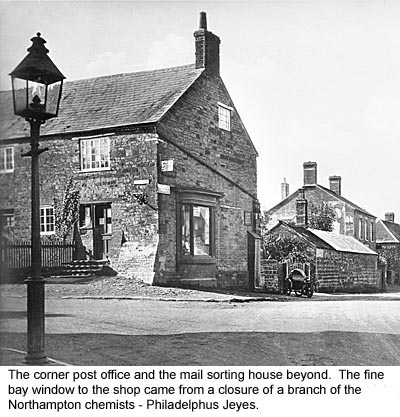 By the early 1880s a William Hickson takes up the
village postal trade, but as Mr. Warren stayed in his cottage Mr. Hickson took
over the corner premises on the Stoke Road and High Street as his Post
Office. This is the corner building shown here and it continued as the
location for Blisworth post office up to 31 October 1984. By the turn of the
century, Sub-postmaster Alfred Pike took over the premises vacated by Mr
Hickson. He states for the 1901 census that his profession is miller and
grocer whilst his daughter Marion is a telegraphist - he was being modest
perhaps. In 1903 the trade
directory listed Mr A.Pike as sub-postmaster with the following obscure abbreviations:
MO, TO, THO, ED, PP, SB, A&IO, IBL together with the postal address of
Blisworth RSO Northants (see also a photograph).
Telegraphed telegrams were part of the daily business
for as yet the 'phone had not come to the village. The Freeston family business
was next door to the Post Office, so the younger boys were often called in to
deliver telegrams to the outskirts of the village and to surrounding villages.
The revenue from telegram deliveries was very handy to the boys. If the telegram
carried good news we were offered a tip or a piece of cake and a drink from the
recipient but quite often the telegram was a dreaded article - it so often told
of disaster, deaths or tragic happenings.
By the early 1880s a William Hickson takes up the
village postal trade, but as Mr. Warren stayed in his cottage Mr. Hickson took
over the corner premises on the Stoke Road and High Street as his Post
Office. This is the corner building shown here and it continued as the
location for Blisworth post office up to 31 October 1984. By the turn of the
century, Sub-postmaster Alfred Pike took over the premises vacated by Mr
Hickson. He states for the 1901 census that his profession is miller and
grocer whilst his daughter Marion is a telegraphist - he was being modest
perhaps. In 1903 the trade
directory listed Mr A.Pike as sub-postmaster with the following obscure abbreviations:
MO, TO, THO, ED, PP, SB, A&IO, IBL together with the postal address of
Blisworth RSO Northants (see also a photograph).
Telegraphed telegrams were part of the daily business
for as yet the 'phone had not come to the village. The Freeston family business
was next door to the Post Office, so the younger boys were often called in to
deliver telegrams to the outskirts of the village and to surrounding villages.
The revenue from telegram deliveries was very handy to the boys. If the telegram
carried good news we were offered a tip or a piece of cake and a drink from the
recipient but quite often the telegram was a dreaded article - it so often told
of disaster, deaths or tragic happenings.
With the Pike family giving up the business, a Mr.
Billingham and his wife took over the Post Office. Their stay was from 1924 to
1936 and they did much to increase the grocery business as well as the postal
side. The next to take over were Mr. and Mrs. Horace Faulkner, followed in 1953 by
Mr. and Mrs. R. Smith, who retired in 1963. Mr. Bruce Newman and his wife Pamela
took over in 1963 and selling out in 1979 to Mr. and Mrs. Frank Bedford who came
to Blisworth and who on 31 October 1984 changed the village pattern by moving
the shop and Post Office to the former Young's
Stores, Mr. Bob Young having sold up
and retired.
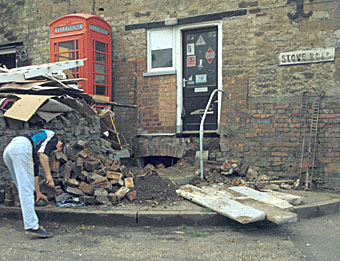 The
old post office in 1992 looked rather sad, there always seemed to be a pile of
rubbish by the door. The phone box was a collectors item, placed there
coincidently, it was never connected but, as indicated below, it recalled some
authoritarian intent. The postal service for Blisworth has been centred at
the sorting headquarters in Bailiff Street, Northampton for many years.
The closure of Blisworth Station in January 1960
probably triggered the change. Our postmen are now dropped off from a post van
and they walk around the village with their bags. Meanwhile, the van is
taken around all the outlying farms and cottages to return to pick up the
walkers.
The
old post office in 1992 looked rather sad, there always seemed to be a pile of
rubbish by the door. The phone box was a collectors item, placed there
coincidently, it was never connected but, as indicated below, it recalled some
authoritarian intent. The postal service for Blisworth has been centred at
the sorting headquarters in Bailiff Street, Northampton for many years.
The closure of Blisworth Station in January 1960
probably triggered the change. Our postmen are now dropped off from a post van
and they walk around the village with their bags. Meanwhile, the van is
taken around all the outlying farms and cottages to return to pick up the
walkers.
Now to elaborate on the growth of the telephone
service. Prior to 1921, the only telephones at Blisworth were the ones used by
the railway staff at the then important railway station. These were for the
internal workings of that huge framework of tracks and trains. As an under the
counter act, the railway lines often carried non-railway information such as
racing tips or local news - handy but it all depended on your personal
relationship with some railway office staff. Just to the north of the station is
Blisworth Arm, at which there were (and still are) the wharf yards of the canal
company. The stretch of the canal from Braunston to Cosgrove was managed by Mr.
Millner who lived at the Arm in the imposing house by the bridge. He controlled
his canal and workers using telegrams or slips of paper carried by lengthmen. It
was very natural for him to think of the telephone as a more efficient means of
communication. His chief, Mr. Gordon Thomas, did not agree and wrote - "I
have placed this matter before the Chairman and he does not consider there is
the necessity at present for the telephone". The GPO (ie. General Post
Office) needed to have three subscribers to make the initial installation
financially viable. Although Mr. Alfred Westley of the Messrs Westley Brothers
and Clarke Company at the roller flour mill (now converted to residential accommodation)
was interested, he wrote to Millner in 1913 - "Dear Mr. Millner. Thanks for
your letter of the 5th inst, but I am afraid that we shall not get it, as so few
want it". The next move came from the GPO three years later when they again
touted for 3 subscribers. But again the 3 were not forthcoming. Then followed
seven years of silence before the canal engineer, Mr. Millner, applied again for
a telephone, supported by 7 other subscribers who were willing to pay the rental
of £2 5s per quarter plus phone call charges. There followed a period of delays
and apologies from the GPO engineers - "shortage of materials" they
said. But at last the Blisworth Arm waterways house and toll house were
connected on 14 May 1921 with the Northampton number 973. Mr. Millner's triumph
was short-lived, for in September the canal company's chairman decided that the
phone was too costly and the contract was terminated. On 14 May 1922 he writes
to his Chairman - "... begging to report that the Post Office engineers
have removed the telephone. I hope they will leave the posts and wires intact
for sooner or later I quite think it advisable to restore the telephone to this
office". It was not until 1924 that he got his phone connection restored,
together with the seven new numbers. All eight were connected to a small
exchange at Roade. Our bacon factory displayed their phone number on their
van; Roade 7. Soon afterwards, however, a single manual switchboard was
installed in the Stoke Road corner post office at Blisworth. The shop area was
tiny in those days and customers buying goods and those wishing to use the
switchboard phone might be blended into one queue - all able to watch the
telephonist with her equipment and loops of cables. What a splendid place to
pick up gossip!
In April 1932 a new telephone kiosk was offered by the
GPO, to be placed by the Post Office door. This site was opposed by
the Parish Council and for four years the location was discussed, first on the
Cross, then by the Elm, until it was placed opposite the Royal Oak a little way
towards the Elm Tree. This box is still sited there. The councillors
of the 30s would be astounded to know that their telephone box, planted in 1935
or 1936, is now Grade II
listed and protected forever (see elsewhere
for other listed buildings in the village).
According to the 'listing'
record it is a "Type
K6 cast iron box designed in 1935 by Sir Giles Gilbert Scott, 1880 –
1960, who won the competition to design Liverpool Cathedral at the
age of 21.
This cast iron square kiosk with domed roof was made by various
contractors with un-perforated crowns to top panels & margin glazing to
windows & doors."
In
April 1936 the Council wrote to the GPO to enquire why, during
weekdays, the box must not be used for fire emergences, to which the reply was
that the box was on a 'party-line' and was shared by the exchange operator in
the Post Office. It was she who should deal with such
emergencies! By January 1947 the box was placed on a separate line, this
action presumably facilitated by the replacement of the operator with a tiny
automatic exchange set up in a wooden shed. This exchange used Strowger
switches - the sort that rack up or down and then rotate stepwise - which
survived until the digital age (1975). This is the shed located 25
yards down Little Lane which is now owned by a Northampton scuba diving club and
used for their meetings and storage. Through the massive expansion in telephones
use, this shed soon became too limiting and a patch of land behind it was purchased
by the GPO to build a large new exchange which would serve the
villages of Blisworth,
Milton and Gayton. The new exchange building was completed in 1971 and
finally came into operation in August 1973. By the mid 1990s this building contained only a compact rack of
electronics boards, rather than ticking relays, serving over 10000 subscriber lines, with room to 'broadband-enable'
them all, which occupies space similar to that available in a tiny
kitchen. That's progress - the equipment could all go back into the
shed!
In 2008 the listed phone box still stands in the High
Street. Many of its glass panels have been replaced by strong plastic
inserts. The jobs-worth in BT has commented that, as it is hardly used
these days, it will be removed, listed or not, if repair costs get too high.
Blisworth has witnessed, as diverse means of
communication, first the turnpike (now a bypass),
then the canal, the railway
and, somewhat near at hand, the M1 motorway. In addition, the canal
towpaths across the country were popular routes for telegraph and telephone
lines, as the pictures below indicate. The towpath was again irresistible
for a new information highway based on a bundle of optical fibres, linking
Birmingham to London, which was installed in the 1990s.
Appendix: Appearance of
telegraph/telephone posts, 1880 - 1950
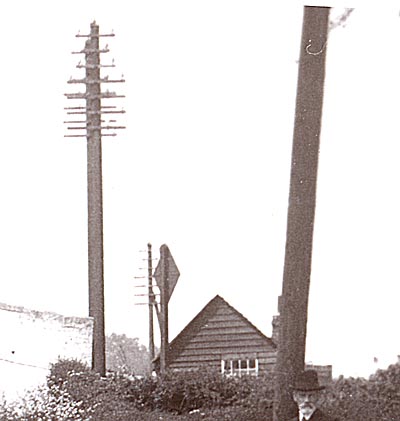 |
Approximately 1880
and on.
These are telegraph lines at Candle
bridge. They are characterised by inequal cross pieces that
allowed a line to slacken without touching the line immediately
below. The insulators are tiny. In many installations there
were no insulators at all - just iron pegs set in the wood. Leakage currents were
seemingly of no concern to the telegraph engineers. Candle
Cottage here is a wooden structure, being a forerunner of the simple
brick hut known of until about 1985. |
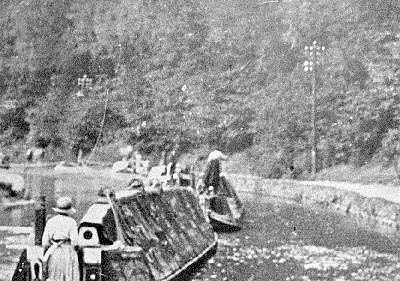 |
Approximately 1925
and on.
A square rigging with rather large insulators
indicates use of telephone lines (even though in the early days of the
telephone some of these lines might still have been carrying telegraphic
messages.) |
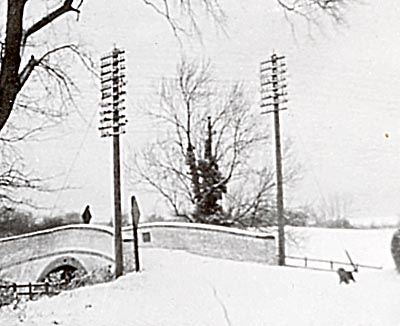 |
Post WWII - this
is actually 1947 at Candle Bridge.
Posts are often taller and carry many more
cross pieces of stouter proportions. It was not until the 1950s
and 1960s that virtual all phone line clusters such as this were placed
underground. |
 |
Recognisable to
everyone; the distribution poles pepper our residential streets and
group our houses into clusters served by underground cables.
New housing groups are now connected underground,
at the time they are built, by either the telephone or a commercial 'cable'
company. However the poles shown here will be with us for many decades. |
 In 1845 the branch line from Blisworth to Peterborough
was opened. This then put Northampton on a direct communication with the main
line here. Mail continued to come to Blisworth with the same use of the catch
nets but now the mails for Northampton were carried by hand along the line to
the station and forwarded by train. Mails for the Towcester area continued to be
taken by Mail cart until the railway to Towcester was opened in 1866. Even after
the area had total rail communication, high speed trains continued to use the
'eject and pick up' method until World War II. This had to be discontinued owing
to the enforced black-outs for as the apparatus was along the high embankment
between the station and the arch, torches and lanterns had to be used. From
about 1860, Blisworth station became designated as a Railway Sub Office (RSO) at which
some sorting was done and this was all that was necessary for letters addressed
to the village, apart from the person's name. There is a
1936 directory copied to this site which might have been used at the RSO to
work out who lived where. The inset shows an example of an RSO
stamped envelope (courtesy of D. Smeathers). Later it was requested that
Northants be added, This continued well into this century. As the years went on,
Blisworth served the villages of Gayton, Milton, Collingtree and Rothersthorpe
with mail, most of which came to the village in bulk and was sorted in an
outhouse next to the Post office. Distribution, was by walking or on bicycle.
The outhouse protruded into the road and left no space for a pavement. It
might have been used as a pickle bottling shop at some time, postwar, before
being demolished for reason of pedestrian safety in the 1960s. Before this
time the postal sorting had been shifted to Northampton and the local village
knowledge of everyone's address was lost. In 1952 the village was re-organised
with a new array of house numbers which we have to this day.
In 1845 the branch line from Blisworth to Peterborough
was opened. This then put Northampton on a direct communication with the main
line here. Mail continued to come to Blisworth with the same use of the catch
nets but now the mails for Northampton were carried by hand along the line to
the station and forwarded by train. Mails for the Towcester area continued to be
taken by Mail cart until the railway to Towcester was opened in 1866. Even after
the area had total rail communication, high speed trains continued to use the
'eject and pick up' method until World War II. This had to be discontinued owing
to the enforced black-outs for as the apparatus was along the high embankment
between the station and the arch, torches and lanterns had to be used. From
about 1860, Blisworth station became designated as a Railway Sub Office (RSO) at which
some sorting was done and this was all that was necessary for letters addressed
to the village, apart from the person's name. There is a
1936 directory copied to this site which might have been used at the RSO to
work out who lived where. The inset shows an example of an RSO
stamped envelope (courtesy of D. Smeathers). Later it was requested that
Northants be added, This continued well into this century. As the years went on,
Blisworth served the villages of Gayton, Milton, Collingtree and Rothersthorpe
with mail, most of which came to the village in bulk and was sorted in an
outhouse next to the Post office. Distribution, was by walking or on bicycle.
The outhouse protruded into the road and left no space for a pavement. It
might have been used as a pickle bottling shop at some time, postwar, before
being demolished for reason of pedestrian safety in the 1960s. Before this
time the postal sorting had been shifted to Northampton and the local village
knowledge of everyone's address was lost. In 1952 the village was re-organised
with a new array of house numbers which we have to this day.
 By the early 1880s a William Hickson takes up the
village postal trade, but as Mr. Warren stayed in his cottage Mr. Hickson took
over the corner premises on the Stoke Road and High Street as his Post
Office. This is the corner building shown here and it continued as the
location for Blisworth post office up to 31 October 1984. By the turn of the
century,
By the early 1880s a William Hickson takes up the
village postal trade, but as Mr. Warren stayed in his cottage Mr. Hickson took
over the corner premises on the Stoke Road and High Street as his Post
Office. This is the corner building shown here and it continued as the
location for Blisworth post office up to 31 October 1984. By the turn of the
century,  The
old post office in 1992 looked rather sad, there always seemed to be a pile of
rubbish by the door. The phone box was a collectors item, placed there
coincidently, it was never connected but, as indicated below, it recalled some
authoritarian intent. The postal service for Blisworth has been centred at
the sorting headquarters in Bailiff Street, Northampton for many years.
The closure of
The
old post office in 1992 looked rather sad, there always seemed to be a pile of
rubbish by the door. The phone box was a collectors item, placed there
coincidently, it was never connected but, as indicated below, it recalled some
authoritarian intent. The postal service for Blisworth has been centred at
the sorting headquarters in Bailiff Street, Northampton for many years.
The closure of 


